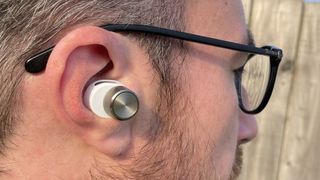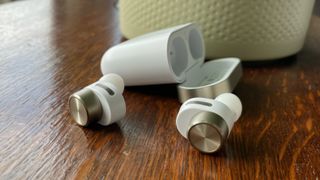If you want the short version of this Bowers & Wilkins PI7 review, it's this: despite being so much more expensive than even the best true wireless earbuds, these not only justify their price, they feel like a damn good deal. They're so good, they won the Best Headphones and Best True Wireless Earbuds awards at the T3 Awards 2021.
You know when you bite into a perfect steak, or a delectable desert, and you just feel this instant sense of relaxation and comfort? And it's usually accompanied by a sigh and a slight slump into your seat, if you're in a movie? That's what these headphones did to me the second I fired up my first song.
What a finely finished fillet of audio. What a rich, deep, chocolate ganache of sound. I am writing this shortly after the watching the Masterchef final, as you may have surmised, and I want to applaud Bowers & Wilkins for the smoothness of its pop purée, and deep meatiness of the sonic sauce slathered all over my music.
Are these the best wireless earbuds on the market? For me, there's no question… they're my favourite headphones I've used in years. Maybe ever, when you factor in the convenience.
But there is a huge caveat for some people: the size of the earbuds might mean that they are literally too big to fit in your ears if you're quite small. We'll come to that.
Bowers & Wilkins PI7 review: Price & release date
The Bowers & Wilkins PI7 were released on April 21st 2021, and cost an alarming £349/$399/AU$599. While most true wireless earbuds are cruising continuously down in price, Bowers & Wilkins has rocketed right into the stratosphere.
The price here is way beyond Apple's AirPods Pro, or even Bang & Olufsen's newest version of the E8 headphones. You'll even be paying more than some of the higher-end best noise-cancelling headphones with over-ear designs, such as the Sony WH-1000XM4.
But from what you've read so far, it might not come as much of a shock that we think the price justifies itself when you hear them – if you can afford to pay this much, there won't be one second of regret. And they have some really good extra features to help solidify the idea that they're worth the outlay.

Bowers & Wilkins PI7 review: Features
The PI7 are debuting alongside the cheaper (and less well-specified) PI5 as Bowers & Wilkins' first sets of true wireless headphones, and the company has gone in hard when it comes to features for its most premium model.
The sound is provided by a dual-driver system in each ear: a 9.2mm custom driver and a high-frequency 'balanced armature' driver, each with its own separate amplifier.
Backing that up is support for aptX Adaptive Bluetooth connectivity with compatible devices, and the connection between the two earbuds is 24-bit/48kHz, so B&W is really targeting these for Hi-Res Audio crowd – though they're certainly not exclusively for them, in our experience.
B&W has also included an excellent feature that means high-quality audio is more accessible than ever if you're using the PI7. It comes with a USB-C-to-USB-C cable and a 3.5mm-to-USB-C cable in the box. You can use either of these to plug the PI7's case into a computer or analogue audio source, effectively as a wireless adapter. The case will then send sound to the headphones over aptX LL (so: CD-quality audio).
This is a great feature not just for convenience (use them with your Nintendo Switch! Or with plane entertainment systems!), but also for improving the quality of wireless audio from something like a MacBook Air, if you have high-quality files or use a hi-fi-friendly streaming service.
Speaking of using them on planes, B&W has also included active noise cancellation. B&W says that it's an adaptive system, tweaking its levels of input depending on the ambient noise automatically.
There are touch-based controls on the outside of the earbuds, which are mostly fine, though they don't work with gloves on (unlike AirPods Pro or Samsung Galaxy Buds Pro) and are a little easy to trigger accidentally while adjusting the fit.
However, we are astounded that there's no way to activate the transparency mode for the noise cancellation using the touch controls. You have to go all the way into the B&W Headphones app to activate or deactivate it. You can activate or deactivate the ANC with the touch controls, but not the transparency mode. We hope B&W will offer an update so you can customise how this works.
You can trigger Siri or Google Assistant using a press on the controls, along with the usual things such as skipping tracks and pausing.
B&W rates the battery life for around four hours in the earbuds per charge, with another 16 hours from the case. Our experience with the earbuds is that they last for a whole morning of work without dying on us, so four hours seems like a fair estimation generally. This is on a par with AirPods Pro, but newer models tend to get more than this, though. That said, I think four hours is probably long enough for most people listening times in daily life.
You can also use the headphones as a Bluetooth repeater, sharing their sound to a second Bluetooth device.

Bowers & Wilkins PI7 review: Fit and design
The B&W PI7 come in a case that's fairly large for current premium wireless earbuds – in terms of volume, it's much bigger than the case for the AirPods Pro or Samsung Galaxy Buds Pro. However, B&W has used a tapered design, so it's pocketable still without causing a bulge you'd rather avoid.
The earbuds themselves are rather large, and stick out quite a way from your ears. Having recently tested the exquisitely discreet Samsung Buds Plus, this does look a bit unsightly to me overall, but it's very common among sound-focused true wireless earbuds, and these are among the least-awkward looking I've seen, thanks to the dual-tone colouring. I also recently tried Panasonic's RZ-S500W, which stick out just as much but with an all-black design that looks even more robotic. So I'm good with the PI7's effect on balance.
However, here we come to the single biggest (potential) issue with the PI7: they literally did not fit in the ear of one of our test subjects. They're not really bigger in volume than other high-end options, but they extend their body backwards from the earpieces more than other headphones we've seen. Most of the rivals will more extend forwards, downwards or, indeed, outwards. Going backwards proved to be a major problem for one of our testers.
But first, the good news: I am a 6' 2" man with an average-sized head. (That's not the good news). The PI7 fit me extremely well using the medium fittings (that bit is), and were totally solid in the ear for lighter tasks such walking outdoors or household chores, while being comfortable and stable for long periods. I like the fit a lot, though I'm not sure I'd stick with them regularly for running or other more bumpy activities – I think Powerbeats Pro remain the safest choice there.

But I gave them to a 5' 0" woman, and even with the smaller in-ear fitting, she is simply unable to wear the PI7. The size of the rear protrusion is too large, and the curves of her ear mean there's no way it can sit correctly.
Normally, I would give the headphones to more people to try to gauge how many other people this happened with, but that's not possible under pandemic conditions. So for now, I'll say that if you're a smaller-than-average women in particular and are looking to buy these, be prepared that the first you'll need to do is test the fit, and understand that you may need to return them.
We asked Bowers & Wilkins about this, and it said: "The size, shape and profile of human ears is almost infinite in its variety so it is almost impossible to make a product that fits absolutely everyone, although of course, we have done our best. It’s an issue that’s doubly difficult with [true wireless] products as they include an incredible amount of technology in a form factor that at the same time, consumers would like to be as small as possible. With the PI7 we also wanted to guarantee class-leading sound quality, so we have gone further than most by fitting two drivers and two amplifiers into each bud – in addition to the aptX Adaptive and ANC tech – which again has an impact on size and form factor."
All of which is understandable, but it's frustrating to see another area of tech in which it's women who will statistically be the ones most likely to miss out – you see it often in smartwatches, for example, many of which only come in larger sizes, such as the new OnePlus Watch. It's also worth noting that this is the first time I've ever seen an earbud that literally cannot fit in someone's ear (though I have seen over-ear headphones that can't be adjusted small enough to fit certain smaller adult women's heads securely in the past).
The build quality of the headphones feels premium. The battery case is just a little cheap-feeling compared to the AirPods Pro or Samsung Buds Pro cases – the plastic lid and its hinge feel quite basic – but that's not a big deal really.

Bowers & Wilkins PI7 review: Performance
Well I've already spilled the beans about this part. The PI7 don't just sound good, they sound phenomenal.
The thing that becomes immediately apparent is that there are no compromises here. Everything from its timing to its balance are exactly what I want from a pair of headphones I'll love to wear day in, day out.
Bass is big and gripping, but never overwhelming and always precisely controlled, like Lewis Hamilton weaving a lorry through a chicane. It's deep and resonant, with enough nuance to really add to the realism of instrumentation – it means you can hear the full graduated impact of a drum kit, or the resonance of an acoustic guitar, as well as giving bass synth all the muscle it needs.
But the big bass knows its place, and never gets in the way of anything else. Mids have energy and warmth that makes them just an immense amount of fun for pop, but also all the detail you need for haunting voices to include every croak, or instrumentation to include finger movements, without getting lost in the mix.
And the high-end manages to stand out clear from everything else, while also not feeling detached, and never coming across as artificial or hard. Cymbals splash, voices hit natural peaks, piano resonates, all distinct and clear, but also part of the overall mix.
If this all just sounds like I'm describing how music should be, then… well, you're onto why I like these headphones so much. Every element feels like it's been allowed to be the most important element. All at once. And it works.
This is all just as true of using regular streaming services over non-aptX Bluetooth as well using high-quality files and connectivity.
I have no complaints about the sound at all personally, but it's not quite what I would call neutral. It isn't drastically coloured, but there's definitely punch to it, and I think some people might prefer a slightly flatter presentation, and there's no EQ option or anything in B&W's app to enable them to do that, which is a bit of a shame.
The noise cancellation is good, too, though doesn't excel in the way the sound does. Wireless earbuds are never quite as strong as the best over-ear options, and that's the case here too. The PI7 is good at reducing consistent droning noises to almost nothing, and really stamps down hubbub in places such as shops. Turning the ANC on and off on a busy road honestly didn't make that much of a difference, but when combined with a good ear seal and – crucially – the power of the actual audio, these are definitely good for hearing music that sounds full despite any outside noise.
While music quality is impeccable, connectivity is a little more average. When you remove the headphones from the case, they're a moment slower to connect than the very best I've tried (the Samsung Galaxy Buds Plus and AirPods Pro), and I've found that sometimes only one bud will fire up initially if you take them out of the case one at a time too slowly. It's easy to fix if the other doesn't connect (just replace in the case for a moment), and I've quickly got in the habit of taking them out together when possible.
They also have a pretty average wireless range, and don't reconnect as quickly if they do drop connection when you walk through the house or something. Again, none of this puts me off them, but there are slicker wireless experiences to be had.
However, the feature of using the case as a wireless adapter is just excellent, and seamless. Plug the case into a computer, choose it as the audio output on your PC, and start playing something. The headphones make a little noise to indicate they're switching sources, and suddenly I'm listening to Qobuz in aptX from a Mac that doesn't support it. No extra DAC required.

Bowers & Wilkins PI7 review: Verdict
There's no surprise twist at the end here. The Bowers & Wilkins PI7 needed to be exceptional in a world of excellent headphones that are half the price, and they are. They've ruined other true wireless headphones I've been happily enjoying for years.
There's no question in my mind that they earn their £349/$399 price tag solidly, and the part I love most is getting this kind of audio quality in something so versatile – all the convenience, none of the compromise.
However, while they fit me really comfortably and securely, this is the first time I've seen a pair of in-ear earbuds that someone literally couldn't use due to their small ear size/shape. So obviously consider this five-star review a verdict for someone who they do fit.
Bowers & Wilkins PI7 review: Also consider
Bang & Olufsen's E8 (3rd gen) and Master & Dynamic's MW08 are the two big expensive and luxe true wireless heavyweights. Both offer big battery life – MW08 is around 10 hours per charge of the headphones, while the E8 promises 35 hours total including the charge case. Both are way beyond the PI7's battery rating.
The B&O E8 is the smaller and slicker of the three for in-ear looks, while the Master & Dynamic MW08 is an even more stand-out design than the PI7, so you're balancing style and audio features well with the PI7. However, the E8 doesn't offer active noise cancellation, so for actual features, only the MW08 matches the PI7.
If you're looking for the slick connection experience (and smaller size), we've already mentioned the Samsung Galaxy Buds Pro a lot, which are both instant to connect and also rock solid for reliability over Bluetooth, no matter what device you connect them to. They sound good, but not a patch on the PI7. And on iPhone, AirPods Pro are super-slick for connectivity, and offer really excellent sound and strong noise cancellation… but the music sounds better with B&W.





